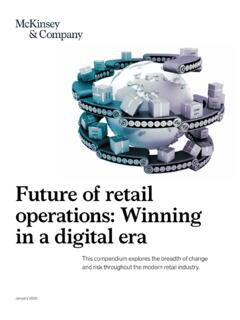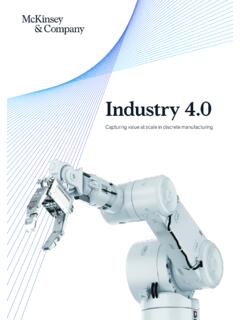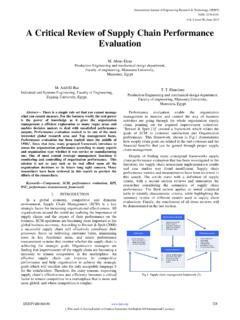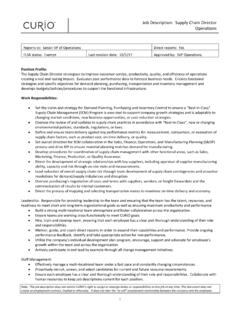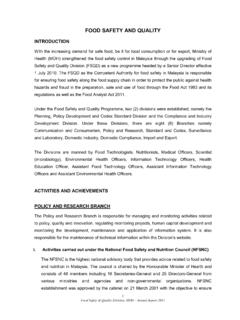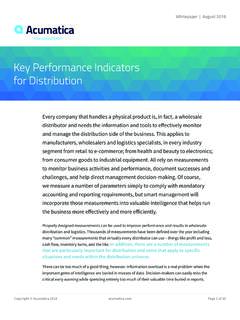Transcription of Analytical assortment optimization - McKinsey & Company
1 October 2019 Retail AnalyticsAnalytical assortment optimizationMaximizing assortment profitability at the push of a button. Cover image: FrankRamspott/Getty ImagesCopyright 2019 McKinsey & Company . All rights reserved. This publication is not intended to be used as the basis for trading in the shares of any Company or for undertaking any other complex or significant financial transaction without consulting appropriate professional part of this publication may be copied or redistributed in any form without the prior written consent of McKinsey & of contentsExecutive summaryAssortment optimization s growing importance and power in overall retail performanceNavigating the assortment optimization cycleThe core.
2 Laying the organizational foundationGetting started23 61416An ever-growing number of SKUs to choose from, limited shelf space, heterogeneous store characteristics, and supply chain complexity put increasing pressure on retailers to get assortment right. assortment management has evolved significantly beyond simple performance metrics such as total sales or rotation numbers. In fact, big data and advanced analytics now enable comprehensive analyses of customer behavior at the push of a button. An example of this is McKinsey s walk rate metric, which quantifies a product s uniqueness by predicting the share of product sales that transfer to other products in the category when the product is delisted and the share that would walk away and be lost sales for the retailer.
3 Retailers that effectively apply the full set of assortment analytics can enjoy increased gross margins of up to four percentage points the Analytical assortment optimization journey is straightforward. A four- to six-week pilot can allow a retailer to quantify the value of its assortment lever based on a few select categories and generate actionable insights for immediate summary2 Analytical assortment optimizationSecuring value through systematic assortment optimization in an increasingly complex and space-constrained retail landscape Finding and maintaining the optimal assortment of products to sell in stores has always been at the core of a retailer s commercial activity.
4 Retailers who get the assortment right enjoy more sales, higher gross margins, leaner operations, and most importantly, more loyal developments in the market make assortment optimization more important than ever:A growing number of SKUs: Large brands are continuously innovating and increasing the number of their SKUs. While small brands may offer fewer individual SKUs, the number of small brands is rapidly increasing. Finally, the number and share of private-label products is also growing at a brisk pace. Limited physical shelf space: As the number of products is growing, shelf space is not. Opportunities to expand or reallocate shelf space between sections is limited to nonexistent.
5 And many new stores are opening in space-constrained, inner-city markets, exacerbating shelf space challenges. Growing supply chain complexity: Even though the number of SKUs continues to grow, the supply chain becomes increasingly complex, compounding the need for thorough reviews of what should be listed or removed from the agony of choice on the endless virtual shelves: Even in e-commerce, where there is presumably infinite shelf space, retailers must manage assortment to hold customers attention and control the costs of inventory and logistics. Location-specific dynamics: Diversity is growing across each retailer s stores, with increasing variation in size and format.
6 Location factors, such as traffic connection and neighborhood sociodemographics, mean that not all SKUs and categories perform similarly across all stores. assortment must therefore be optimized to the specifics of each store location. This optimization typically involves macrospace allocation (how much space to dedicate to a specific category in each individual store) and localization (finding the optimal SKU mix for each store). Developing a more Analytical assortment management process pays off, as the insights gained can lead to improvements across several areas. These improvements can significantly enhance financial performance (Exhibit 1): Systematic delisting.
7 The ability to steer customers toward higher-margin products can contribute up to of a percentage point to gross margins. Work with leading international retail players shows that a significant reduction in SKUs can be achieved without endangering sales levels (see sidebar Less is more: assortment optimization in e-grocery ). assortment optimization s growing importance and power in overall retail performance 13 Analytical assortment optimization Revenue increase through strategic listing. Retailers could realize an additional 2 to 4 percent increase in sales through a more customer-centric product portfolio. Simplified supply chain .
8 A margin improvement of up to of a percentage point can come from a reduction of costs related to operations and supply chain , as well as in situations where there is a high share of private-label products product development. Improved procurement conditions. Knowing a product s uniqueness the likelihood that a customer will replace it with another provides retailers with important information when deciding whether to delist a product or an entire brand. Knowing not to be reliant on a particular product or brand, retailers will have more bargaining power with suppliers regarding their terms. This advantage can lower procurement costs by up to 3 percent.
9 Capturing value from assortment optimization through advanced analytics Significant improvement in financial performance and customer experience is possible through assortment optimization , but it requires a deep understanding of assortment performance beyond the superficial. For instance, strategic listing entails more than introducing every hot item that comes to market. Similarly, smart delisting is more than cutting slow-moving items. Indeed, determining which SKUs to cut to make space for new ones requires not just a detailed, store-level look at financial performance but a deep understanding of customer purchasing behavior as well.
10 This means, for example, quantifying how unique an SKU is for the customer or identifying the customer needs that must be covered by the selection of products in the category. Exhibit 1 McK Consumer and retail practice 2019 Analytical assortment brochureExhibit 1 of 8E ective assortment management can signi cantly improve nancial annual contribution across individual value leversSystematic delistingStrategic listingSimpli ed supply chainImproved procurement conditionsUp to pp of margin2 4% revenue growthUp to pp of margin1 3% of procurement costsPro t margin improvement from better product mixCoverage of previously neglected or underrepresented customer needsLower operating cost in supply chain , branch operation.

